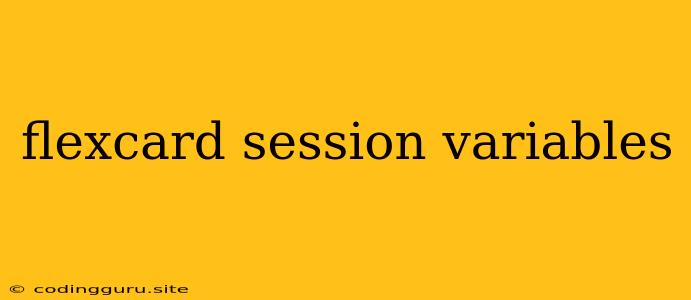What are FlexCard Session Variables and Why are They Important?
FlexCards, a powerful feature within Salesforce, are customizable cards that provide users with a visual and interactive way to access information and perform actions within Salesforce. These cards can be tailored to specific users and their roles, offering a personalized and efficient way to navigate and manage data. However, to truly maximize the potential of FlexCards, understanding and utilizing flexcard session variables is crucial.
Flexcard session variables act as dynamic placeholders that allow you to inject context-specific data directly into your FlexCards. This data can be anything from the user's name and their current task to information related to a specific record, object, or even external data sources. This dynamic nature enables the creation of highly personalized and context-aware FlexCards that are both informative and actionable.
How do FlexCard Session Variables work?
Flexcard session variables are essentially key-value pairs that are stored in a session for a specific user. These variables are set when the user triggers a FlexCard action or when the FlexCard itself is initialized. Here's a breakdown of the process:
- Initialization: When a FlexCard is initiated, its associated code may set default flexcard session variables. These variables might include information about the user's role, the current record they are viewing, or other relevant data.
- Action Trigger: When a user interacts with a FlexCard (e.g., clicking a button or entering data into a form), the FlexCard's code can set or update flexcard session variables. This might involve storing the user's input, the ID of a newly created record, or any other data relevant to the action.
- Data Retrieval: Throughout the FlexCard's lifespan, its components (such as text fields, buttons, or dynamic content) can access and utilize these flexcard session variables. This allows for real-time updates and display of relevant information based on the user's actions and context.
Why Use FlexCard Session Variables?
Using flexcard session variables offers a range of benefits for both developers and users:
- Increased personalization: Tailor FlexCards to each user's specific needs by dynamically displaying relevant information and actions based on their roles, context, and preferences.
- Improved efficiency: Simplify complex workflows by pre-populating forms, providing context-specific data, and eliminating the need for users to manually enter or search for information.
- Enhanced user experience: Create interactive and engaging experiences by displaying dynamic content, updating information in real-time, and providing immediate feedback on user actions.
- Simplified development: Streamline FlexCard development by using flexcard session variables to manage and share data across different components and actions within a FlexCard.
Example: Using FlexCard Session Variables in a Sales Opportunity
Let's imagine a FlexCard designed to help sales representatives manage their opportunities. The FlexCard might display information such as the opportunity name, stage, owner, and estimated revenue.
Here's how FlexCard session variables can be used in this scenario:
- Initialization: Upon opening the FlexCard, the session variables are set with data from the current opportunity record. This might include variables like "opportunityName", "opportunityStage", "opportunityOwner", and "estimatedRevenue".
- User interaction: The sales rep might update the opportunity stage to "Negotiation" by clicking a button on the FlexCard. This action will trigger a code update, changing the "opportunityStage" session variable.
- Dynamic display: The FlexCard dynamically updates the "Stage" field to "Negotiation", reflecting the user's action and providing instant feedback.
This simple example demonstrates how flexcard session variables enable dynamic updates, user-specific data display, and a seamless user experience within FlexCards.
Best Practices for Using FlexCard Session Variables
To effectively leverage flexcard session variables in your FlexCard development, consider these best practices:
- Use descriptive variable names: Choose variable names that accurately reflect the data they hold to improve code readability and maintainability.
- Limit the scope of session variables: Only set variables that are truly necessary and directly relevant to the FlexCard's functionality. Avoid unnecessary variables that may clutter the session and affect performance.
- Document variable usage: Clearly document the purpose, data types, and expected values of each session variable for future reference and maintenance.
- Consider security implications: Be aware of security considerations, particularly when using session variables to store sensitive data. Implement appropriate security measures to protect user information.
Conclusion
Flexcard session variables are an integral part of creating powerful, dynamic, and personalized FlexCards in Salesforce. By understanding the concept and implementing them effectively, you can take your FlexCard development to the next level, delivering a superior user experience and streamlining your processes.
